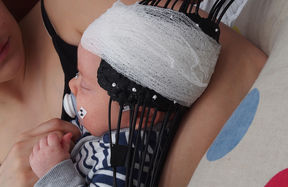Expectant mothers’ pregnancy-related anxiety may alter how infant brains respond to sad speech

A study has shown a potential link between pregnancy-related anxiety and how a baby’s brains respond to sad speech. Researchers at Aalto University and the University of Turku in Finland showed that mothers with high anxiety scores at 24 weeks of pregnancy gave birth to babies who had reduced brain responses to sad-sounding speech. The effect was significantly smaller at 34 weeks of pregnancy, suggesting the effects of pregnancy-related anxiety may be transferred more easily to the unborn baby in mid- rather than late pregnancy. Studying a larger group would make it possible to understand the behavioral implications of the observed changes.
“Areas of the baby’s brain that deal with emotion and speech were less active when listening to sad speech if the baby’s mothers had reported high pregnancy-related anxiety” said Dr Ilkka Nissilä, a research fellow at Aalto University who is one of the authors of the study.
Pregnancy-related anxiety refers to worries specifically concerning the pregnancy, such as worries about changes in appearance, labor and birth, the health of the developing child and future parenting. Previous studies have already shown a link between anxiety during pregnancy and neurodevelopment in infants, which prompted the researchers to investigate emotional speech and anxiety in this study.
“While we can observe a change in brain response, we can’t say for sure how it is related to behavior, or how the changes we’ve observed affect the child over time ” said Dr Nissilä. “What we know for certain is that a larger study with more subjects is needed to understand how such observations made using neuroimaging are related to the development of the babies as they grow up.”
Professor Hasse Karlsson, professor of integrative neuroscience and psychiatry at the University of Turku said "One of the advantages of the FinnBrain study is that the babies will be followed up for several years. This makes it possible to later find out if this finding is related to any clinically relevant outcomes.”
The study examined the data of 19 mother-baby pairs from Finland. The brain scanning was done with a technique called diffuse optical tomography or DOT, which uses a set of light sources and detectors attached on the side of the baby’s head to measure changes in blood flow in the brain. The method allows the study to take place while the baby is in its mother’s lap, and is almost silent, as opposed to the fMRI scans often used in functional neuroscience experiments which require lying still in a loud scanner. The DOT equipment meant that the researchers could easily play speech sounds to the babies whilst simultaneously scanning their brains. They hope to be able to improve the DOT technology further for future work by making it wireless.
The work was published in the Journal of Affective Disorders, you can access the full open-access paper here https://doi.org/10.1016/j.jad.2019.10.047. The research was carried out as part of a collaboration between Aalto University, University of Turku, University of Helsinki and Helsinki University Hospital. The mothers and babies were part of the FinnBrain birth cohort study , and the research was funded by the Academy of Finland, Jane and Aatos Erkko Foundation, Signe and Ane Gyllenberg Foundation, State Research Grant (EVO), Yrjö Jahnsson Foundation, the Finnish Society of Sciences and Letters and the National Graduate School of Clinical Investigation (VKTK).
Ilkka Nissilä
Researcher
Aalto University
[email protected]
p. +358 40 5799988
Hasse Karlsson
Professor
University of Turku
[email protected]
p. +358 50 321 7827
- Published:
- Updated:
Read more news

Seed funding available to boost collaboration between Aalto, KU Leuven and University of Helsinki
Aalto University, KU Leuven and the University of Helsinki launch the 2nd exploratory seed funding call to explore research collaboration possibilities. The funding call is open until 10 September 2024.
Just believing that an AI is helping boosts your performance
People perform better if they think they have an AI assistant – even when they’ve been told it’s unreliable and won’t help them